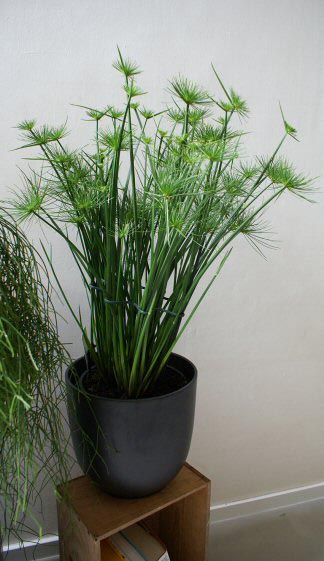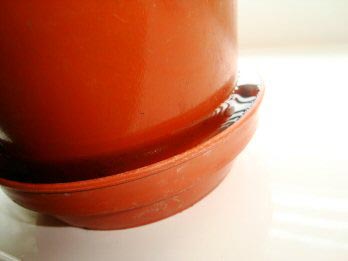





Cyperus is commonly known as Umbrella Grass, Umbrella Plant, Umbrella Papyrus, Umbrella Sedge or the Umbrella Palm. The Umbrella element of its various names comes from the leaflets that grow on top of the tall stems which (wait for it) look like the spokes of an Umbrella, giving an overall attractive and novel appearance. With age the leaves and stems eventually form a grass-like clump, and this look is distinctly different to the other commonly grown Umbrella Plant i.e. Schefflera. In order to avoid confusion we're going to use Umbrella Grass as its primary name, but all of the above names are equally valid.
The Umbrella element of its various names comes from the leaflets that grow on top of the tall stems which (wait for it) look like the spokes of an Umbrella, giving an overall attractive and novel appearance. With age the leaves and stems eventually form a grass-like clump, and this look is distinctly different to the other commonly grown Umbrella Plant i.e. Schefflera. In order to avoid confusion we're going to use Umbrella Grass as its primary name, but all of the above names are equally valid.
This houseplant is very unique and its the only plant we've written about to date which can not (99% of the time) be killed by overwatering. Theoretically, Umbrella Grass is actually a pond or aquatic plant which resembles water water reeds. It's very adapted to having its roots completely surrounded by water at all times and ultimately this is something that's needed if you want a good looking Cyperus. It grows just as well indoors as it does in a pond as long as you ensure the roots are kept constantly wet, to help with this you may want to keep the pot your Umbrella Grass is growing in, in a container or a drip tray. If you choose a drip tray with a tall edge, you'll be able to reduce the frequency you need to top it up.
Although you must not underwater this plant at anytime, in all other ways the Umbrella Grass is actually a very easy houseplant. It copes with a range of light and temperature levels, grows quickly and is easily propagated so if you become a fan it's very easy to grow more plants or give them away as unusual presents.  In some parts of the world the above traits have meant it's been classed as an invasive plant, but on the whole and in the context of them being "houseplants" this is rarely a problem as they are neatly contained in pots.
In some parts of the world the above traits have meant it's been classed as an invasive plant, but on the whole and in the context of them being "houseplants" this is rarely a problem as they are neatly contained in pots.
There are various Cyperus species that are suitable for being grown indoors as a houseplants. The most popular ones today are C. alternifolius (pictured left), and C. haspan (pictured above). You may also find C. diffusus or C. involucratus in the outdoor garden plants section of garden centers. They can be grown indoors if you wish, but because they're very vigorous, bushy and somewhat untidy they're best suited to being grown outdoors in a pond or very boggy area in your yard. You may also come across the rare C. albostriatus variegatus which is highly attractive due to its variegated leaves.
Light
Very adaptable and accommodating for the most part, Umbrella Grass can be grown equally well in full sun, bright light, light shade or medium shade. If things are too dark it will tell you by producing very few new shoots and stems.
Watering
Can you over water a Cyperus plant? Not really is the answer. Very simply you must provide a high level of water saturation at all times to keep your Umbrella Grass healthy and lush looking so do try to keep the drip tray (or whatever the pot is sitting in) topped up at all times. Unlike many other houseplants this requirement isn't something you can negotiate on as doing so will quickly cause ugly effects with the arrival of brown splotches on the leaves or completely yellow / brown Umbrella Grass stems.  The only time you can cut back on the watering is if temperatures go very low, too much water at this point could cause damage through rotting. Additionally do not immerse the entire pot in water for the same reason.
The only time you can cut back on the watering is if temperatures go very low, too much water at this point could cause damage through rotting. Additionally do not immerse the entire pot in water for the same reason.
Humidity
If you've followed the above instructions you can ignore humidity requirements as no additional humidity needs to be provided. This is because the constant moisture at the roots will raise the humidity levels naturally around the plant.
Feeding
Although it can produce a lot of growth, in comparison to bigger plants it will obviously not use as much feed. This means you only need to feed occasionally, perhaps once a month at standard strength when the plant is in active growth.
Temperature
This is a plant that outdoors is quite hardy and this is mirrored indoors. A temperature range between 10°C / 50°F to 22°C / 72°F will be perfect. Cooler temperatures down to around 4°C / 39°F are accepted for short periods. Be careful if things get too warm as this will cause a rapid drying of the soil which is undesired.
Copyright © www.100flowers.win Botanic Garden All Rights Reserved